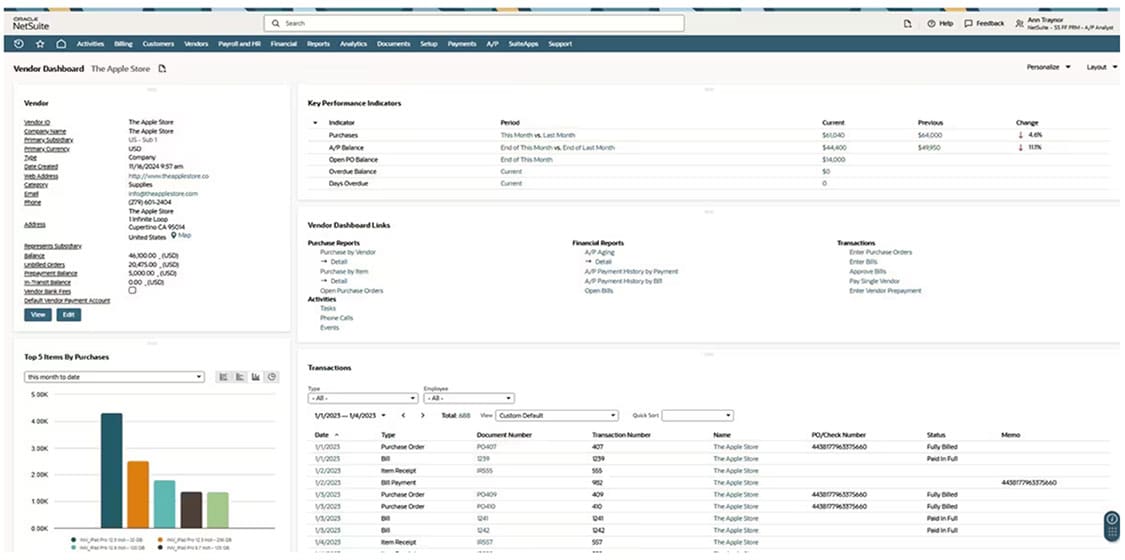Managing vendor relationships involves more than sending contracts and cutting checks. It’s a series of decisions, approvals, handoffs, and follow-ups that can quickly break down without the right support.
For smaller organizations, manual vendor management processes might work—until they can’t keep up, which tends to happen as companies scale. It only takes one missed approval, a slow handoff, or an outdated record to throw the whole process off balance. Automation can fix those weak spots, while also giving procurement and finance teams a better way to manage vendor relationships from start to finish.
This article explores how automation changes the vendor lifecycle, what to expect from the software, and how to pick a system that seamlessly builds on your existing operations.
What Is Vendor Management Automation?
Vendor management automation refers to the use of software to perform vendor activities in a consistent, organized way. Instead of chasing down approvals for contracts or onboarding documents, teams rely on automated workflows to route requests, send reminders, track deadlines, and organize vendor information.
These capabilities are typically incorporated into broader procurement systems or ERP solutions to help move vendor data seamlessly into related modules, such as purchasing or spend analysis. Some organizations choose to begin cautiously, initially limiting automation to onboarding, for example, then expanding implementation as processes mature. For companies juggling a large number of vendors, automation cuts down on repetitive work and helps processes run more reliably.
Key Takeaways
- Vendor management automation solutions handle vendor activities in a consistent, organized way, replacing manual steps with easy-to-manage workflows.
- Automation solutions follow the vendor lifecycle from initial setup to performance tracking and offboarding.
- Companies that automate are often able to reduce risk, improve visibility, and free employees’ time for more strategic work.
- Beneficial system features, such as integration with other systems and configurable compliance checks, help uphold both control and flexibility.
- Choosing software that coexists with existing processes makes rollouts smoother and adoption more likely.
Vendor Automation Explained
Automating vendor management presupposes the use of technology to handle key steps in the vendor management lifecycle and not relying on manual work. Every step from initial sourcing to final offboarding is supported by distinct digital workflows that can reduce human error, speed up response times, and improve vendor performance metrics, such as on-time delivery and quality.
In many cases, automated workflows replace tasks that involve emails, spreadsheets, and siloed files, such as to collect documentation, route approvals, and update performance records. Automation allows teams to respond faster when something goes wrong (think: a missed deadline or compliance issue) and reduce the risk of skipping an approval step or other missteps. Automated systems also typically maintain logs of major workflow steps, recording what has been done and when. This creates an audit trail that is much clearer than anything obtained through email chains or scattered spreadsheets.
The Vendor Management Lifecycle
Vendor management spans a series of decisions and handoffs that begin well before a contract is signed. Teams must assess vendor capabilities, evaluate bids, collect W-9 forms and insurance certificates, review pricing terms, onboard vendors, and monitor ongoing performance. The danger lies in performing this end-to-end process—collectively known as supplier lifecycle management—as an isolated process, allowing mistakes to get compounded and small delays to turn into larger issues. By contrast, automating this procedure connects these activities through a shared system, so everyone has a clear view of what’s happening. Procurement teams can then use this visibility to track results, and finance staff can time payments appropriately. As a whole, with automation, the vendor management lifecycle becomes easier to manage and less prone to disruption.
Why Do Companies Automate Vendor Management?
Manual vendor management often involves fragmented systems and drawn-out approval processes. Different departments may rely on separate spreadsheets, emails, or portals to complete the same processes—finance might track payments in one system, while procurement manages contracts in another and legal reviews agreements via email chains. The result is often marred by redundant efforts and greater opportunities for miscommunication.
Automation relies on a centralized platform to efficiently manage vendors and remove these coordination roadblocks. It also builds more consistent enforcement of procurement policies across locations or teams, since everyone follows the same standardized workflows. Companies that automate can also respond faster to problems, since all information is centralized (no need to hunt through scattered files). Meanwhile, consistent, trackable processes reduce noncompliance risks.
Benefits of Vendor Management Automation
Vendor management automation replaces inconsistency-prone processes with systems that are easier to manage and less likely to create delays. The following benefits allow procurement and finance teams to focus on strategy, rather than on chasing down paperwork or reconciling disconnected systems:
- Increased efficiency: Automated workflows keep approvals moving by routing tasks to the right people and flagging delays. Teams waste less time checking email threads and chasing down signatures.
- Improved data visibility: Dashboards in vendor automation systems literally provide a clear view into vendor status, outstanding tasks, and recent performance, all of which helps managers make prompt decisions.
- Simplified onboarding: Instead of trading documents back and forth, new vendors complete required forms and upload certificates through one interface. Internal teams can review submissions as soon as they’re received to avoid backlogs.
- Risk mitigation: Compliance checks can be built directly into the process, so reviews happen automatically, even before a vendor is approved or paid. This reduces exposure to both financial and legal risk.
- Cost savings: Automating manual steps lowers labor costs and shortens cycle times. When fewer hours are spent sorting through exceptions, teams can spend more time on higher-value work.
- Improved vendor relationships: Vendor automation can decrease onboarding time and minimize payment delays, building trust. That kind of consistency lends itself to a stronger foundation, leading to better collaboration in the future.
How to Automate Vendor Management
The following list lays out a step-by-step process for automating vendor management, beginning with mapping current workflows. Companies should take a deliberate approach toward aligning technology choices with business goals. To drive faster adoption and better results, consider a solution that builds on and enhances existing processes, rather than one that forces teams to rebuild workflows from the ground up. Systems that call for completely new ways of working tend to meet resistance and can disrupt operations during implementation.
1. Map Out Your Current Processes
Trace how vendors move through processes, from intake to offboarding. Lay out where handoffs happen, who makes decisions, and the way information proceeds from one step to the next. Discover where things slow down or break. The best insights often come from the people doing the work, not from reports, so solicit employee feedback. Having a baseline understanding of how work actually gets done helps you zero in on what’s worth fixing based on frequency and impact, and what’s working well enough to leave alone.
2. Identify Opportunities for Automation in Your Workflow
Once the current situation has been mapped, highlight where repetitive tasks exist, such as email approvals, data entry, or document routing. Look for stages where information has to be re-entered into different systems or where approvals frequently get stuck. Evaluate which parts of the process take the most time to complete or are most frustrating for users. Automation should prioritize fixing these pressure points. Start with high-volume, low-complexity tasks for the quickest return.
3. Define Which Features Will Get You to Your Goals
Now translate the friction points you’ve identified into specific feature requirements. If email approvals are causing delays, look for systems with automated routing and escalation capabilities. When data has to be re-entered across multiple systems, prioritize tools with strong ERP integration. For processes where approvals get stuck, focus on features such as real-time dashboards and approval tracking. Document must-have features that remedy your biggest pain points, then identify nice-to-have capabilities that could improve efficiency further. This feature list should become your scorecard for evaluation criteria; don’t get distracted by bells and whistles that don’t solve your actual problems.
4. Evaluate Vendor Management Automation Solutions
Evaluation starts by looking into the features that matter most. Companies shouldn’t have to adapt to new software; if a tool checks every box but still feels clunky in testing, be aware that user adoption will likely suffer. The right solution should fit the way the business already works, especially when it comes to ERP integration and procurement processes. Supplier case studies can offer insights into how the system performs in real settings, but direct conversations with customers will likely reveal more. Remember: Cost includes more than the license fees—don’t forget to factor in implementation, training, support, and integration expenses for a true picture of total investment. Implementation timelines and training complexity also influence how quickly you’ll realize benefits.
5. Create an Implementation Plan
Your implementation plan sets the pace for everything that follows. Roles should be assigned early: Who will lead the project, handle technical setup, manage data migration, and coordinate training? Make sure timelines account for more than just setup, as testing and training also take time. Vendor data must be cleaned up before migration begins. Throughout implementation, communication matters just as much as execution, especially when multiple teams rely on the same system. The plan should describe how teams currently collaborate and build on those existing communication patterns. Procurement, finance, and IT all deserve the same level of understanding about what’s changing and when.
6. Test Your Implementation
Testing should happen in a controlled environment before anything goes live. A small group, perhaps a single vendor type or one department, will yield just enough real-world testing to see if the system holds up, without involving the complexity of a full rollout. Performance can be measured by how fast tasks move or how easily users get through their work. Early feedback will indicate where the setup needs adjustment. It’s better to fix those issues now than deal with them during a full rollout.
7. Train Your Team
Training works best when it fits the way people actually use the system. Buyers, approvers, and finance staff each need a version that reflects their tasks, rather than one that offers a generic overview. Hands-on sessions in a test environment help teams learn without the risk of committing real errors. Documentation should be simple to follow and easy to find later. Questions will keep coming after go-live, so support should continue to be active well past the rollout.
8. Organizational Rollout
Avoid a big-bang rollout. Rolling out the system in stages gives teams time to adjust. Start with groups that already understand the process, such as those that were involved in the testing phase or that are generally tech-savvy and most familiar with vendor management workflows. They’re most likely to adopt the new system quickly. Keep an eye on usage as the rollout unfolds, and make sure support is easy to reach. Feedback during this phase helps fine-tune training and catch incipient problems. A few visible wins, like faster onboarding times or fewer approval bottlenecks, can help other teams see the value and get on board.
9. Continuous Improvement and Refinement
Once the system is in place, the work shifts to making sure it continues to be useful. Metrics will show where things ae slowing or slipping. Feedback from everyday users often points to problems faster than reports will. As processes change, workflows need to keep up. Updates from the software vendor can also unlock features that weren’t part of the original rollout. The system should keep evolving as the business does.
Features of Vendor Management Automation Solutions
The most effective vendor management systems reduce administrative work and give teams a clearer view of what’s happening behind the scenes. The following features help procurement and finance staff stay coordinated to prevent miscommunications that can lead to duplicated payments, missed renewal deadlines, or other costly mistakes:
- Workflow automation: Tasks, such as contract approvals and compliance checks, move through predefined workflows with fewer manual steps. As a result, approvals don’t stall, because the next action is automatically routed to the right person.
- Dashboards and reporting: Users can check vendor status in real time and spot delays as they happen. Reports reflect current activity, so decisions are based on what’s actually going on, rather than on an outdated export from last week.
- Real-time performance management: Key metrics are tracked continuously, not pulled on demand. When vendor performance dips below expectations or deadlines slip, teams can act quickly to remedy issues, instead of finding out about them only later.
- Integration with other software: Vendor data can connect directly to ERP and other finance systems, so teams don’t have to re-enter information in multiple places. This reduces human-introduced errors and shortens the procure-to-pay cycle
Vendor Management Automation Challenges
While vendor management automation offers significant benefits, it doesn’t solve everything. Companies will need to work through the following roadblocks, beginning with data security concerns and extending to user adoption hurdles, before any benefits show up:
- Data security: Storing vendor data in a digital system raises real concerns about access and protection. The risk decreases with stronger encryption and role-based access controls, as well as regular audits of user permissions.
- Compliance commitments: Managing compliance across different vendors can result in complexity for automation systems. The system needs to support rules that may vary by contract, region, or risk profile. Built-in checks tied to specific workflows help guarantee compliance without slowing things down.
- User adoption and stakeholder buy-in: The best systems will still fail if people don’t use them, especially if the new process feels too different from current workflows or requires extensive retraining. Early communication, thorough training, and visible wins, such as fewer duplicated payments or cleaner records, make the change easier to support.
- Integration with existing systems: Older systems don’t always play nicely with newer platforms. The best results come from solutions that connect easily or from progressive rollout plans that don’t try to change everything at once.
Choosing the Right Vendor Management Software
Selecting the right vendor automation solution is predicated on careful evaluation of how well each option fits your needs. Success depends on finding a tool that integrates smoothly with existing operations but also provides the support, scalability, and compliance features your business requires. Companies evaluating vendor management solutions should consider the following criteria:
- Support for the full vendor lifecycle: A strong platform tracks every step from initial review through offboarding, without forcing teams to work with multiple disparate tools.
- Integration with ERP and finance systems: Direct connections avert double entries and help synchronize payments, budgets, and contracts.
- Scalability for future growth: As vendor lists inevitably expand or workflows become more complex, the solution should keep pace through a flexible architecture and easy configuration changes, without requiring a rebuild.
- Built-in compliance and audit features: The system must document who did what and when, provide automatic compliance updates as regulations change, and maintain clear audit trails that record approvals and exceptions.
- Structured onboarding support: Implementation goes faster when vendors provide templates and a clear path from setup to go-live. Ongoing support during and after the transition period means teams can get reliable help should issues arise.
- Workflow and dashboard customization: Procurement, finance, and IT teams all operate a little differently, so the system should allow changes to routing logic, layout, and data views without involving extensive development work.
Keep Tabs on Vendor Performance With NetSuite
NetSuite Vendor Management brings vendor data into the same system used for procurement, contracts, and payments. This helps eliminate the workarounds that come with managing vendors through separate tools. Workflows cover key vendor tasks—for example, onboarding, performance tracking, and compliance—that can be updated without necessitating extensive setup. The result is easier adjustments as vendor requirements or internal policies shift. Because NetSuite runs in the cloud, staff members can work from the same record no matter where they are. This also means that vendor information will remain current and that reports will reflect live activity, rather than disconnected data from multiple systems.
NetSuite Vendor Dashboard

Automation changes how teams manage the entire vendor lifecycle from onboarding through performance tracking. Instead of relying on emails, spreadsheets, and other manual processes, companies can build systems that enhance existing workflows and scale over time. Ultimately, that leads to fewer mistakes, better coordination between departments, and a clearer view of what vendors are actually delivering.
#1 Cloud ERP
Software
Vendor Management Automation FAQs
What is automation in procurement?
Automation in procurement means using software to handle routine tasks that would otherwise take hours of manual work to complete. Automation allows approvals, vendor setup, and purchase tracking to move through defined steps without constant follow-up. It helps teams respond faster and with fewer errors.
What is vendor invoice automation?
Vendor invoice automation uses software to process invoices without relying on email chains or manual information entry. It matches invoices to purchase orders, checks for discrepancies, and routes documents for approval automatically. The result is fewer delays and more time to review exceptions that need a closer look.
What KPIs measure vendor management automation implementation?
Several key performance indicators (KPIs) measure the success of vendor management automation. Some focus on speed, such as how long it takes to onboard a vendor or approve an invoice. Others track accuracy by noting error rates or mismatches between systems. Adoption rates also matter, especially early in the rollout. The right mix depends on where the process is struggling most.









